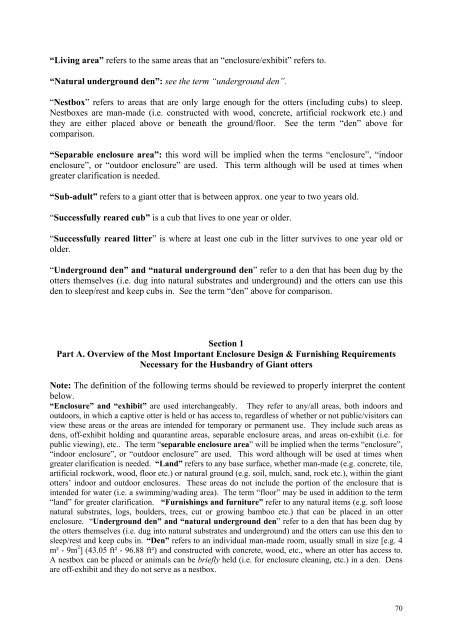International Giant Otter Studbook Husbandry and Management
International Giant Otter Studbook Husbandry and Management
International Giant Otter Studbook Husbandry and Management
You also want an ePaper? Increase the reach of your titles
YUMPU automatically turns print PDFs into web optimized ePapers that Google loves.
“Living area” refers to the same areas that an “enclosure/exhibit” refers to.<br />
“Natural underground den”: see the term “underground den”.<br />
“Nestbox” refers to areas that are only large enough for the otters (including cubs) to sleep.<br />
Nestboxes are man-made (i.e. constructed with wood, concrete, artificial rockwork etc.) <strong>and</strong><br />
they are either placed above or beneath the ground/floor. See the term “den” above for<br />
comparison.<br />
“Separable enclosure area”: this word will be implied when the terms “enclosure”, “indoor<br />
enclosure”, or “outdoor enclosure” are used. This term although will be used at times when<br />
greater clarification is needed.<br />
“Sub-adult” refers to a giant otter that is between approx. one year to two years old.<br />
“Successfully reared cub” is a cub that lives to one year or older.<br />
“Successfully reared litter” is where at least one cub in the litter survives to one year old or<br />
older.<br />
“Underground den” <strong>and</strong> “natural underground den” refer to a den that has been dug by the<br />
otters themselves (i.e. dug into natural substrates <strong>and</strong> underground) <strong>and</strong> the otters can use this<br />
den to sleep/rest <strong>and</strong> keep cubs in. See the term “den” above for comparison.<br />
Section 1<br />
Part A. Overview of the Most Important Enclosure Design & Furnishing Requirements<br />
Necessary for the <strong>Husb<strong>and</strong>ry</strong> of <strong>Giant</strong> otters<br />
Note: The definition of the following terms should be reviewed to properly interpret the content<br />
below.<br />
“Enclosure” <strong>and</strong> “exhibit” are used interchangeably. They refer to any/all areas, both indoors <strong>and</strong><br />
outdoors, in which a captive otter is held or has access to, regardless of whether or not public/visitors can<br />
view these areas or the areas are intended for temporary or permanent use. They include such areas as<br />
dens, off-exhibit holding <strong>and</strong> quarantine areas, separable enclosure areas, <strong>and</strong> areas on-exhibit (i.e. for<br />
public viewing), etc.. The term “separable enclosure area” will be implied when the terms “enclosure”,<br />
“indoor enclosure”, or “outdoor enclosure” are used. This word although will be used at times when<br />
greater clarification is needed. “L<strong>and</strong>” refers to any base surface, whether man-made (e.g. concrete, tile,<br />
artificial rockwork, wood, floor etc.) or natural ground (e.g. soil, mulch, s<strong>and</strong>, rock etc.), within the giant<br />
otters’ indoor <strong>and</strong> outdoor enclosures. These areas do not include the portion of the enclosure that is<br />
intended for water (i.e. a swimming/wading area). The term “floor” may be used in addition to the term<br />
“l<strong>and</strong>” for greater clarification. “Furnishings <strong>and</strong> furniture” refer to any natural items (e.g. soft loose<br />
natural substrates, logs, boulders, trees, cut or growing bamboo etc.) that can be placed in an otter<br />
enclosure. “Underground den” <strong>and</strong> “natural underground den” refer to a den that has been dug by<br />
the otters themselves (i.e. dug into natural substrates <strong>and</strong> underground) <strong>and</strong> the otters can use this den to<br />
sleep/rest <strong>and</strong> keep cubs in. “Den” refers to an individual man-made room, usually small in size [e.g. 4<br />
m² - 9m 2 ] (43.05 ft² - 96.88 ft²) <strong>and</strong> constructed with concrete, wood, etc., where an otter has access to.<br />
A nestbox can be placed or animals can be briefly held (i.e. for enclosure cleaning, etc.) in a den. Dens<br />
are off-exhibit <strong>and</strong> they do not serve as a nestbox.<br />
70

















